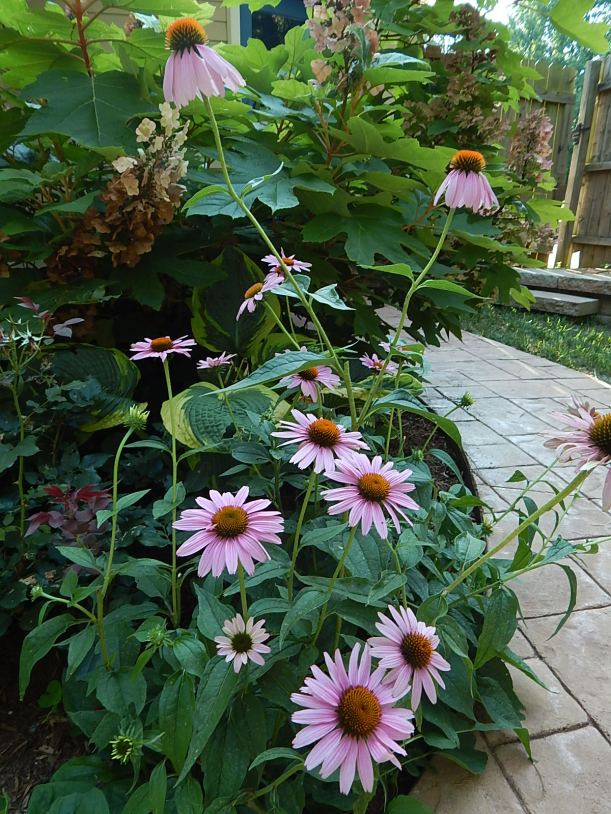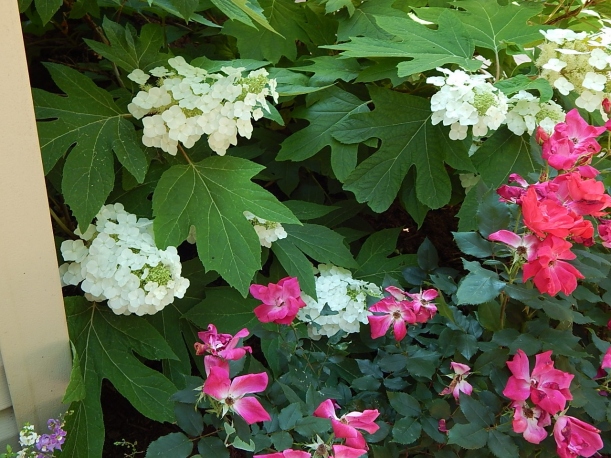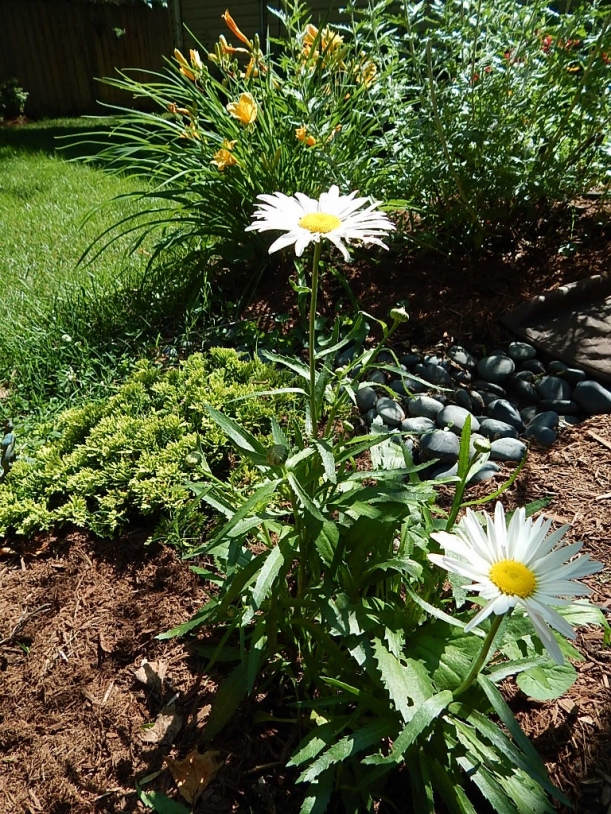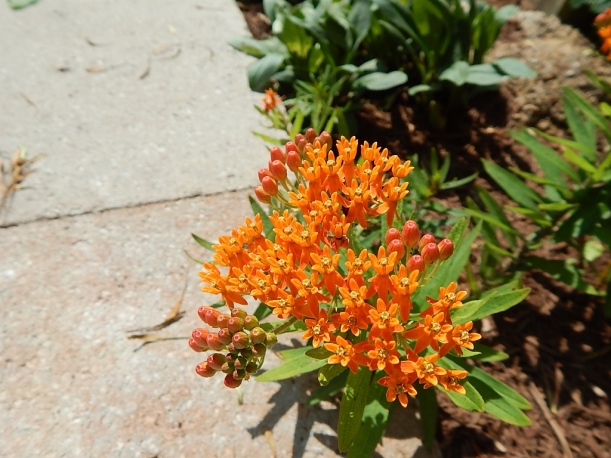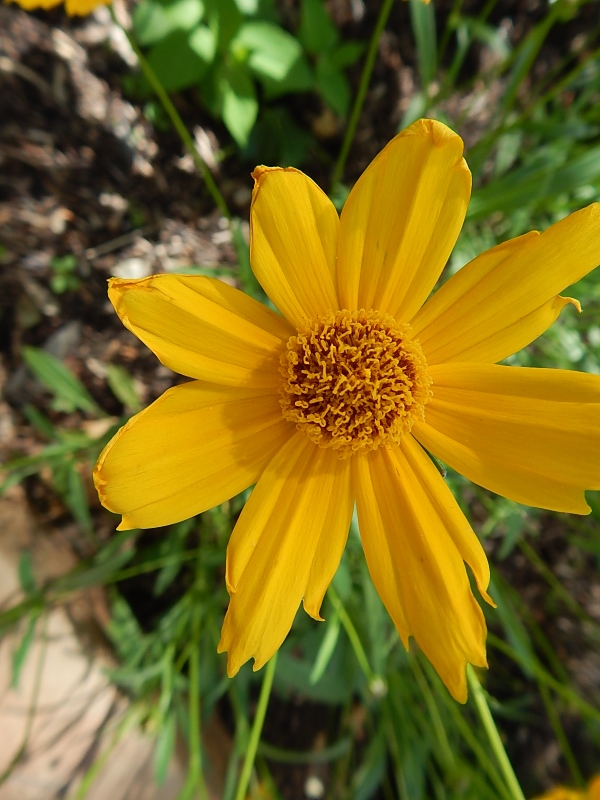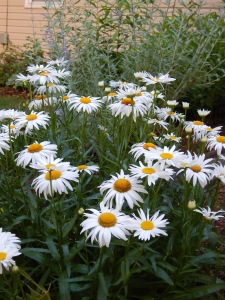
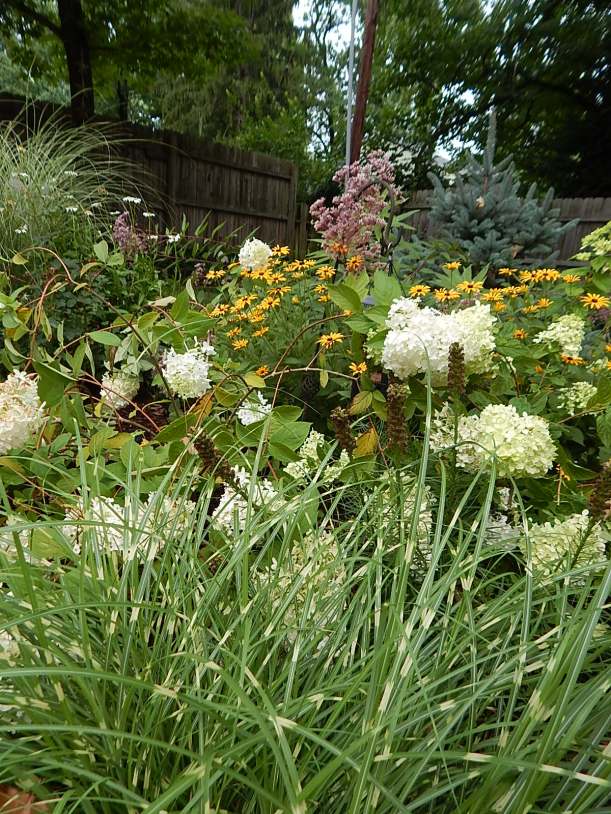


Tag Archives: shasta daisy
Wordless Wednesday: June Swoon

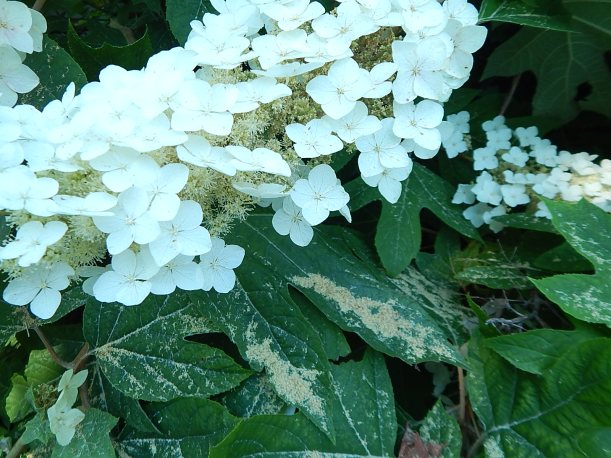
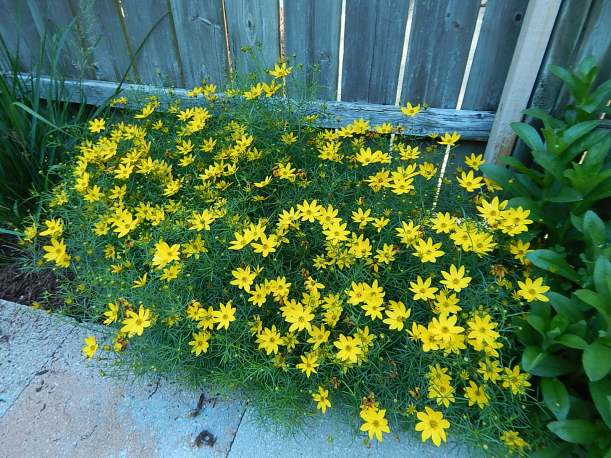

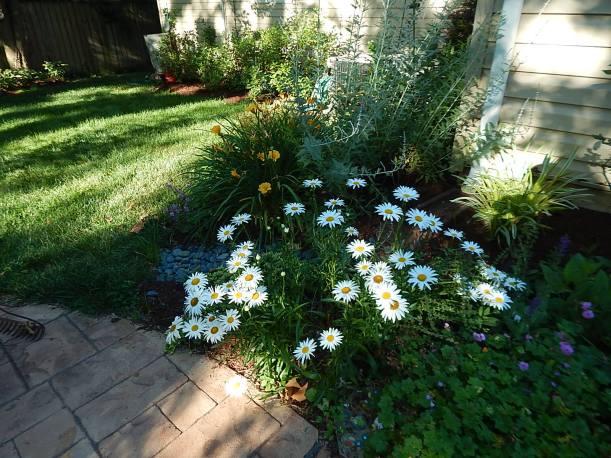
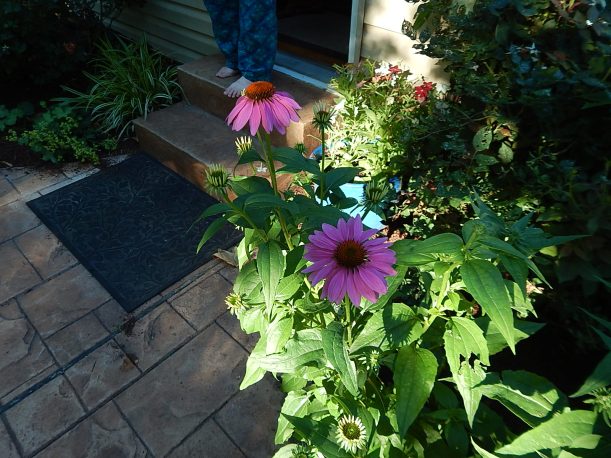
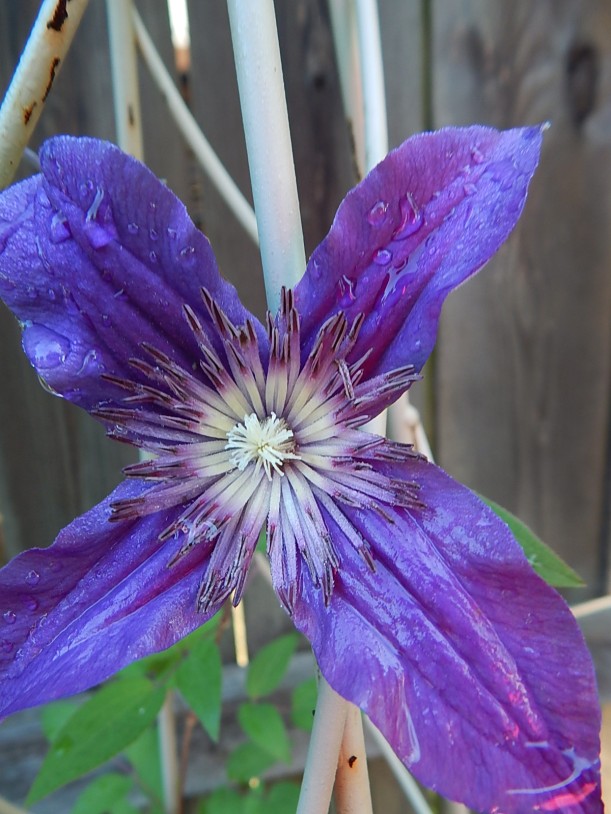

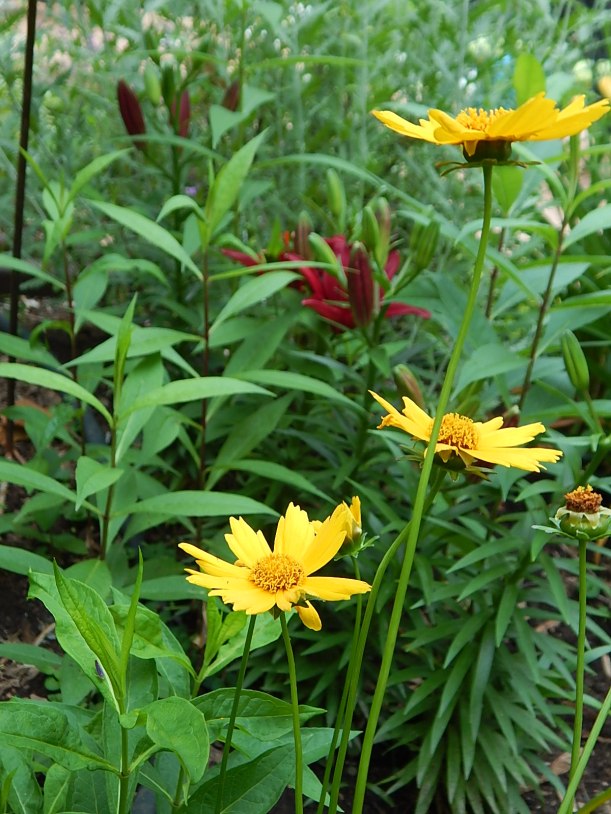

Wordless Wednesday: Summer Go-Togethers
Wordless Wednesday: June Blooms
Feeling Smart, Curious and Happy? Plant Something Yellow

Clusters of small yellow Mecardonia hybrid get along well with everyone in this bright blue container. From the mid-tone purple of the angelonia to the deep pink petunias to the grayish creeping wire vine (Muehlenbeckia axillaris)
Upbeat, optimistic and friendly, yellow flowers cheer a garden like no other.
Purple and pink dominated the garden a few weeks ago, but now the sunny yellows are popping out and in doing so providing a more uplifting feel to the garden altogether. Yellow is a primary color and sits at the light end of the color spectrum. It’s loaded with energy, and placed in the garden can perk up a combination of plants or absolutely shimmer in the sun. It is clearly a color that says, “Notice me!” And in doing so, causes your eye to slow down, rest and take in its warmth. But too much of it can be irritating, too. Some say that’s due to its high energy value. Introducing other colors, such as green (perfect!) help calm yellow.
 This is a color that knows how to network, going beautifully with several shades of purple, pink, green, blue and and even gray. I have found it to be a wonderful transitional color that is at ease at moving between dark and light hues. I have shots of yellow throughout my gardens. For example, a small citron green juniper (Juniperus horizontalis) at the base of the garden bed that wraps around my family room provides a transition from one side of the bed to the other. Certainly placement is important here but so is its lemon-lime color mix. This shrub is small and a slow grower, but it is mighty in its impact. Standing tall next to it are white Shasta daisies (Leucanthemum superbum) with their sunny yellow eyes and Stella de Oro daylily on its other side. Things cool off, though, with a whispery stand of Russian sage (Perovskia).
This is a color that knows how to network, going beautifully with several shades of purple, pink, green, blue and and even gray. I have found it to be a wonderful transitional color that is at ease at moving between dark and light hues. I have shots of yellow throughout my gardens. For example, a small citron green juniper (Juniperus horizontalis) at the base of the garden bed that wraps around my family room provides a transition from one side of the bed to the other. Certainly placement is important here but so is its lemon-lime color mix. This shrub is small and a slow grower, but it is mighty in its impact. Standing tall next to it are white Shasta daisies (Leucanthemum superbum) with their sunny yellow eyes and Stella de Oro daylily on its other side. Things cool off, though, with a whispery stand of Russian sage (Perovskia).

Yellow coreopsis perk up the blue dwarf blue spruce and deep tones of penstemon. It also complements the pink bloom on the yarrow in front.
 Yellow has a high reflectance value. It is the most visible color on the spectrum and that’s most likely why school buses are yellow, as often are school crossing lines on the pavement. It is the color of hazard signs as well. But too much of it can be irritating, too. Some say that’s due to its high energy value. Introducing other colors, such as green (perfect!) help calm yellow. If you’re into the meaning of color, yellow has lots going for it. It’s naturally associated with happiness, creativity, communication and energy. It’s also associate with analytical thinking, inquisitiveness and original thought. On the down side, deceitful, laziness, and cowardice are often used in the same sentence with yellow, as in “He’s nothin’ but a yellow-bellied, no-good, lazy coward!”
Yellow has a high reflectance value. It is the most visible color on the spectrum and that’s most likely why school buses are yellow, as often are school crossing lines on the pavement. It is the color of hazard signs as well. But too much of it can be irritating, too. Some say that’s due to its high energy value. Introducing other colors, such as green (perfect!) help calm yellow. If you’re into the meaning of color, yellow has lots going for it. It’s naturally associated with happiness, creativity, communication and energy. It’s also associate with analytical thinking, inquisitiveness and original thought. On the down side, deceitful, laziness, and cowardice are often used in the same sentence with yellow, as in “He’s nothin’ but a yellow-bellied, no-good, lazy coward!”
What do you think of the color yellow?
Some Like It Hot
In celebration of week-long temperatures above 90 degrees F., here’s a short list of plants that are sumptuous in a St. Louis swelter:
1. Echinacea purpurea. Like black-eye Susan, coneflower is a hardy soul. And breeders have developed an assortment of colors for us choosy gardeners. This year I added a very pretty pink variety called “PowWow Wild Berry.”
2. Gaillardia “Arizona Red Shades.” New to the garden this season, this blanket flower seems very happy and has put out bloom after bloom. It is a short, compact plant that rewards with blooms all season long–from early summer to early fall. And talk about carefee. It performs best in poor, well drained soil (check!), without fertilizer (check!) and in the sun (check!).
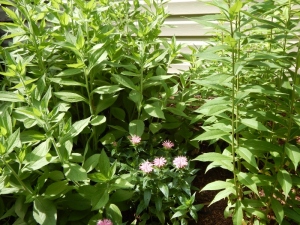
The young beebalm “Pardon My Pink” is dwarfed by black-eyed Susan on the left and tall garden phlox on the right.
3. Rudbeckia “Black-eye Susan.” I have divided the two plants I purchased three years ago at the Webster Groves Women’s Garden Club plant sale and increased the stands of “Susans” in the yard. This is one tough native that likes it hot and loves, loves, loves the sun. Not yet blooming, I look forward to vases full of these sunny flowers.

A nice color combination of yellow coreopsis and orange butterfly milkweed. Growing behind the milkweed is canna, a new addition this year to the fence garden bed.
4. Butterfly milkweed. Another native, the orange blooms on this plant attract butterflies, which are fun to watch flit about the garden. I have it placed next to coreopsis and in front of canna (new to the garden this year).
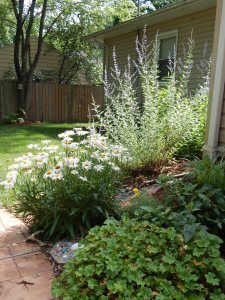
The Russian sage nearly glows in the afternoon sun. And the Shasta daisy seems to be well adapted to this spot which receives lots of sun.
5. Perovskia atriplicifolia.The wispy, powdery-hued wands of Russian sage cool off the heat but hold up well. The tall Russian sage is on the verge of blooming. The specimen shown above anchors the corner of this bed which faces South and East. The East view is what is showing here. Planted nearby are tall garden phlox and hot pink roses.
The Garden in Late May
At the end of April, I posted photos showing how much progress had been made from the start of the month to the beginning of May. Of course, Mother Nature was just getting tuned up. To lean on the old, tired adage “April Showers Bring May Flowers,” I know why Mother’s day, weddings and graduations fill the weekends of May–because it’s so doggone beautiful.
I have not yet mulched. Shame on me but my gutter man has not shown up! And while I know the mulch will make the beds look that much better and be beneficial to the beds, all the rain and nice spring temperatures have really brought on the blooms. The only bed that really looks shabby is along the fence line where the Cannas are starting to emerge. It could use some mulch. And the bed in the corner of the backyard looks terrible, but more about that deliberately neglected space later.
This post isn’t to dive into the rough spots of the yard, but to celebrate how lovely May is.
Let’s take a look at how things are coming along, shall we?
Not shy on ambition, I envisioned a plant-packed bed, spilling forth with flowers throughout spring, summer and fall when I started this project three years ago. And it is taking a lot longer than I thought. I am trying to be patient and let the shrubs fill in, the Japanese maple put some height on and the dwarf Colorado blue spruce fill out, but I am like a kid–I want it now. May was spent dividing hosta, coreopsis, shasta daisy, black eye Susan and other perennials in the beds. They payback is that I save money on plants and have some much-needed repetition, which provides some continuity to this project.
The “May Night” salvia are attracting lots of bees as are the cranesbill. I really like this combination. This must be the perfect spot for the cranesbill because it was the first thing I planted in my new garden in the summer of 2011. The salvia tends to get a bit leggy and last year–its first summer–I cut it back quite a bit. Clearly that didn’t both it!
Pink and purple plants took center stage in early May but now the yellows are starting to show. The coreopsis are balancing atop their delicate stems, and the stella de oro are blooming. Later this summer, the black eye Susans will be out in force.

This variety of coreopsis blooms all summer but requires a bit of maintenance trimming off the spent blooms.
I have been looking forward to watching gayfeather (liatris spicata) come through this year. I planted three of them last year. One did not make it but these two look terrific. It looks like they will bloom soon.
True to their promise, the Knockout roses are providing a profusion of blooms. I am really enjoying this pink shrub. It was mislabeled as a deep pink but it turns out it was a happy accident. It’s also encouraging to see how quickly these guys grow.
Nothing seems to have grown as quickly as the Oakleaf hydrangea! This bad boy either a) loves this spot on the north side of the house; b) is a vigorous grower; or c) all of the above. I think the answer is c) all of the above. This specimen is actually in the middle of this particular bed. When sitting on the patio, it towers above the rose. Behind it, where there is more shade from the eaves of the roofline, I have put in shade lovers such as coral bells, astilbe, hosta and fern. Originally, I had intended the oakleaf to screen the trash cans. This year I decided to move them to the other side of the house and expand this bed. That’s the gardening way, right?
Until May, I had not given much thought on which month I really enjoy in the yard. While early spring provides much-needed anticipation and relief from being inside all winter, the temperatures this May have been good (not too hot or humid). The humidity and temps are starting to climb but it has been a great month to enjoy the yard.
Having something blooming each month throughout the summer is one of the key benefits to gardening. You can bring the outdoors inside with vases of cut flowers, a joyful reminder of the garderner’s hard work paying off.
I like to I look forward to providing an end-of-June report and watching what’s growing in your yard, fellow bloggers.
Thanks for reading.

The black eye Susan here in front of the yellow coreopsis, love this location. Other sun lovers include monarda, tall garden phlox, lily and Russian sage. On the left is a blue false indigo (baptisia australis), a new addition to the bed this year.
In the Garden: What a Difference a Month Makes
Life in the backyard is abuzz with growth! Just one month ago, perennials were just beginning to push their way through the soil. Take a look and see for yourself the plant progress in my St. Louis garden.

This bed beneath the family room window and bordering the patio, looked rather barren on March 29. The small bit of green is Meadow Sage.
I had yet to trim back the roses and still need to add mulch. There are four KnockOut rose shrubs in this bed, three of them planted last year. This bed faces east and gets lots of morning sun as well as sun from the south.

Mother Nature is not the only one who has been busy. I have added the rocks to better direct the drainage from the downspout, cleaned out the bed and trimmed the roses. I have added a few plants as well, although the vast majority are perennials planted over the past three years.
This is one of my favorite beds. Everything I have put in this bed has been happy, happy, happy as Phil would say on Duck Dynasty. In addition to the roses and Mianacht salvia (salvia x sylvestris), there are Cranesbill Biokova Karmina (geranium x cantabrigiense) which edge the bed. These mounding plants have wonderful year round interest, their leaves turning deep green to crimson red in the fall and winter. In early summer they are filled with small rose-hued flowers. Filling in the bed are Shasta daisy(Leucanthemum × superbum), variegated lily turf (liriope muscari), threadleaf coreopsis and new this season, Lady’s Mantle (Alchemilla mollis). I added the lady’s mantle to the north end of the bed, near the door, to bring some yellow to that end of things. I also transplanted a small and struggling shasta that had been in a bed near the fence. Anchoring the bed near the rocks on the south end is a low-to-the ground, creeping juniper (Juniperis horizontalis). This evergreen has lots of yellow in, which complements the hot pink of the roses and brightens the deep purple of the salvia.
I also like this bed because it wraps around to the south, which gets gobs of sun. It begins its southern turn where the Russian Sage (Perovskia atriplicifolia) is anchored. I added two Stella D’Oro lilies(Hemerocallis) to play off the color in the juniper and contrast with the cool lavender of the Russian Sage. This small grouping is a nice segue to the south-facing part of the bed. I’ll share more of that in another post.
How’s your garden growing?







